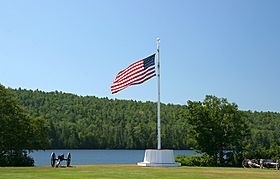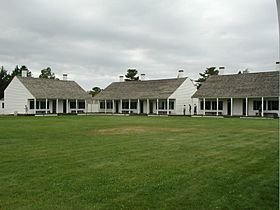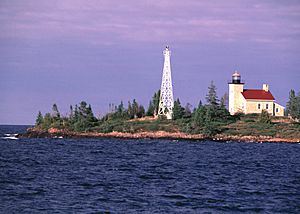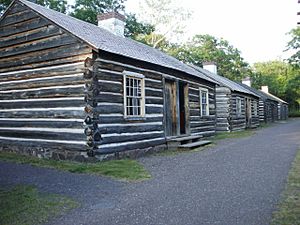Fort Wilkins Historic State Park
Quick facts for kids Fort Wilkins Historic State Park |
|
|---|---|

Flagpole in front of Lake Fanny Hooe at Fort Wilkins
|
|
| Lua error in Module:Location_map at line 420: attempt to index field 'wikibase' (a nil value). | |
| Location | Grant Township, Keweenaw County, Michigan, United States |
| Nearest city | Copper Harbor, Michigan |
| Area | 987 acres (399 ha) |
| Elevation | 620 feet (190 m) |
| Established | 1923 |
| Administered by | Michigan Department of Natural Resources |
| Designation | Michigan state park |
| Website | |
|
Fort Wilkins
|
|

Officer Quarters
|
|
| Location | Fort Wilkins State Park |
| Built | 1844 |
| NRHP reference No. | 70000279 |
| Added to NRHP | July 8, 1970 |
Fort Wilkins Historic State Park is a special place in Copper Harbor, Michigan, managed by the Michigan Department of Natural Resources. This park protects an old army fort from 1844 called Fort Wilkins. The fort is so important that it was added to the National Register of Historic Places in 1970.
The state park covers about 987 acres. It offers fun things like camping and places for day visits. You can also see the historic Copper Harbor Lighthouse, which was built in 1866. Fort Wilkins is also part of the Keweenaw National Historical Park.
Contents
Exploring Fort Wilkins' Past
Copper Harbor is located at the very top of the Keweenaw Peninsula, right next to Lake Superior. It has one of the best natural harbors in Keweenaw County. When copper was found on the peninsula in the 1830s, many people became interested in the area.
In the early 1840s, a "copper rush" began. Lots of people hoping to get rich moved to the peninsula. The U.S. government worried that there might be trouble or fighting. Also, shipping companies asked the government for help with navigation. They needed to ship in supplies and move the valuable copper out safely. Because of these concerns, Fort Wilkins was built in 1844. William Wilkins, who was the Secretary of War at the time, gave the order to build it.
Why Fort Wilkins Was Built
The U.S. Army set up Fort Wilkins in 1844. It was located east of Copper Harbor, between the harbor and Lake Fanny Hooe. The soldiers stationed there had two main jobs. First, they were supposed to help with law enforcement in the area. Second, they needed to keep peace between the miners and the local Ojibwa people. Some of the Chippewa (another name for Ojibwa) did not agree with the Treaty of La Pointe. This treaty had given the land to the United States in 1842–1843.
However, the fort turned out to be mostly unnecessary. The Chippewa people generally accepted the new settlers. The miners also followed the laws. The Army built 27 different buildings at the fort. These included a guardhouse, a place to store gunpowder, and homes for officers and soldiers. There were also barracks, mess halls, a hospital, and various shops. Many of these original buildings are still standing today. Others have been rebuilt after archaeologists studied the old foundations.
When the fort first opened in 1844, two groups of soldiers, called companies, were stationed there. But when the Mexican–American War started, these companies were sent to Texas. Another company replaced them, but they were also sent to the war. By 1846, only one person, Sergeant William Wright, was left to take care of the fort.
After Sergeant Wright passed away in 1855, the fort was rented out. A doctor named John S. Livermore wanted to turn it into a health resort. He hoped people would come to relax during the hot summer months. But this plan didn't happen because he died in 1861.
In 1863, the U.S. government gave land to Michigan and Wisconsin. This land was for building a military road between Fort Wilkins and Fort Howard in Wisconsin. This important road was finished in 1872.
After the American Civil War, the U.S. Army returned to Fort Wilkins. They stayed for three more years, from 1867 to 1870. The army needed a place for soldiers to finish their time serving after the war. Different companies of soldiers were stationed there during this time. The army finally left Fort Wilkins for good at the end of August 1870.
Fort Wilkins Becomes a State Park

In 1848, work began on the Copper Harbor Lighthouse complex. This lighthouse is located at the entrance of the harbor. In 1923, the old fort and the nearby lighthouse became a Michigan state park.
Today, the park is open to visitors during the summer months. You can see staff dressed in old army uniforms. They show what life was like at the fort during its last summer as an active post. The park also offers many outdoor activities. You can go camping, fishing, paddling, and swimming. There's also a 2.5-mile trail for hiking, mountain biking, and cross-country skiing in winter.
See also


